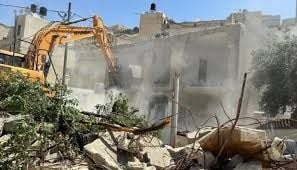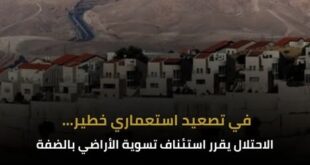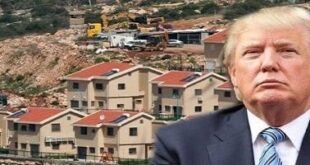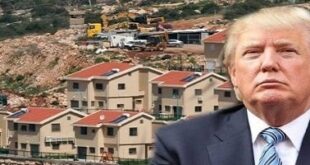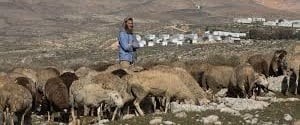By: Madeeha Al-A’raj
The National Bureau for Defending Land and Resisting Settlements stated in its latest weekly report , that Israeli orthodox Minister of Settlement, Orit Strook leads a vast campaign to support the occupation’s settlement activities and allocate additional budgets for this purpose, but at the same time prevents the Palestinian to build in Area C. The ‘Israel Hayom’ Newspaper reported last week that there has been a significant increase in funding the Land Divisions at the settlement councils in the West Bank, as part of Strook’s plan, the Minister of Settlement, which focuses openly on monitoring Palestinian construction not only in Area C but also in Area B, which is administratively under the Palestinian National Authority.
Strook impudently claims that the Palestinians are changing the borders without negotiations anything. They are unilaterally changing the borders and impose as a matter of fact.’ Orit Struck belongs to the Religious Zionism Party, and runs a ministry created by the Netanyahu’s 6th government called the ‘Ministry of Settlement and National Tasks.’ which brings together all the affairs, powers, and budgets of the other ministries related to the West Bank.
According to Newspaper, work has been going on here quietly and secretly for about 2 years, and it includes establishing land divisions in all settlements. Moreover, it has allocated NIS 35,000,000 for this purpose that will be distributed to the settlement councils as follows: Binyamin settlement NIS 3,552,7450s, Mount Hebron 2,573,500, Gush Etzion 2,573,114s, Megilot Yam HaMelech 1,555,250, Efrat 1,006,500, Ariel 1,006,500, Ma’ale Adumim 1,006,500, Immanuel 1,004,960, Kiryat Arba 994,500, Kedumim 957,750. Karnei Shomron 927,500, Beitar Illit 857,750, Knesset 748,750.
Noting that in recent years, the so-called ‘Land Patrols’ teams have begun to operate and become active in the West Bank settlements, monitoring Palestinian construction and agriculture. These patrols submit their reports to the occupation authorities to issue demolition notices and stop work and construction notices to the Palestinians, with the aim of combating the Palestinian presence, especially in Area C in the occupied West Bank.The budgets that the Strook’s mnistry transfers to the settlements include hiring employees for patrol departments and purchasing drones, tablets, and vehicles.
Large settlements will be able to finance the salaries of four full-time guards and four part-timers. The allocated budgets can also be used to employ many volunteers in the national service project, and to hold conferences on preventing Palestinian construction and expansion in Area C. Today, scores of workers in the land departments in all the settlements tour the lands of the West Bank, and this year they have submitted more than 3,800 reports on Palestinian buildings that are illegal according to Israeli occupation.
The leaders of the “Land Patrols” teams say that the patrols have achieved great success and have created a system through which every citizen can submit reports, and this is immediately picked up by the departments and patrols, which immediately go to work. The patrols don’t have the authority to enforce the law or confront with Palestinians. Their job is to document, transmit reports, and work in full cooperation with the Civil Administration. They submit their reports to the occupation authorities, in order to issue demolition notices and stop work and construction notices to Palestinians.
The Civil Administration also operates a hotline calling on settlers to report Palestinian construction, as part of a plan to empty Area C of Palestinians. The occupation authorities use various means managed by the ‘Land Patrols’ after allocating large sums of budgets under the title of ‘monitoring and curbing Palestinian construction and expansion in the West Bank.’ They decided to establish the patrols in 2020, and they officially began operating in 2021. Their work culminated in major steps on the ground in 2022, based on the idea of snitching, according to article in Haaretz Newspaper.
Those ‘informants’ land patrols, who monitor Palestinian construction and agriculture, submit their reports to the occupation authorities to issue demolition and stop-work notices to Palestinians. According to the Human Rights organization ‘Bimkom’, the Civil Administration admitted in 2020 that it approved only 21 requests submitted by Palestinians for building permits in Area C of the West Bank, out of 1,485 requests submitted by them, which means that 98.6% of the requests were rejected in 2016 – 2018. During the same period, the occupation authorities issued 2,147 orders to demolish Palestinian buildings in the same area, under the pretext of unlicensed construction, 90 of which were carried out.
For its part, Haaretz also reported that the Civil Administration provided this data to Bimkom. Thus, the Civil Administration claimed that during this period it issued 56 building permits, but it turned out that 35 of them were not issued based on requests submitted by Palestinians, but rather as part of the occupation’s plan to transfer the Jahalin Bedouin from their place of residence to an area near Al-Ezariya. The permits weren’t implemented. The Civil Administration added that from 2000 – 2018, Palestinians submitted 6,532 requests for building permits in Area C, and only 210 requests i.e, 3.2% were approved, most of the requests that were approved were only for existing buildings, against which demolition orders were issued.
Within the context of demolitions, data from the OCHA indicate that the occupation forces have demolished 988 homes and facilities in Area C of the West Bank since Oct. 7, displacing 934 citizens and harming 44,072 others. The demolitions were concentrated in the cities and towns of Jericho, Anata, Tulkarm, Duma, Hizma, and Idhna. In Areas A and B, the occupation forces demolished 590 homes and facilities, displacing 2,953 citizens and harming 446,833 others.
According to OCHAN, East Jerusalem has suffered greatly from the demolitions, 226 homes and facilities in Jerusalem were demolished during the same period, displacing 621 Palestinians and harming 40,767 others. The demolitions were carried out in 24 towns and neighborhoods in Jerusalem, but were more concentrated in the town of Jabal al-Mukaber, targeting 37 homes and facilities, 21 of which were inhabited, then the town of Silwan, with 31 facilities, 21 of which were inhabited, then the towns of al-Walaja, Beit Hanina, al-Issawiya, and the rest of the towns and neighborhoods of Jerusalem.
The demolition and displacement operations, the situation in the Khan al-Ahmar area has returned to a state of tension. Residents of the settlement outpost that was established near the Palestinian village of Khan al-Ahmar two months ago are threatening the residents of this village and preventing access to the school on the road that passes near the outpost. The new outpost is located dozens of meters from the village homes and is located on top of a hill. This cursed outpost includes a sheep pen and two buildings. The outpost residents travel through the village and shine lights on its homes at night and prevent students from walking on the regular road leading to school.
The villagers say that they cannot sleep in peace because of the harassment, led by the security official in this settlement outpost. Estimates indicate attempts to expel the residents of Khan al-Ahmar and Palestinian Bedouin communities in the area ‘Palestinian villages’ by members of settlement outposts, who settled near the Bedouin communities, noting that from the beginning of the war until the end of last August, 19 Palestinian communities were expelled in this way.
It was said that, hundreds of right-wing and ultra-nationalist Israelis took part in a conference on reestablishing settlements in the Gaza Strip last Monday. The conference held near the Gaza border, attracted a number of prominent parliamentarians, including Netanyahu’s Likud party. Data shows that since Oct. 7, 2023, the movement to re-settle Gaza has moved from the extreme fringes of Israeli society to the political discourse among Netanyahu’s right-wing coalition partners.
Ben Gvir was one of the conference’s most prominent stars, who said, “The land of Israel belongs to all of us.’ Adding that encouraging the emigration of Gazans was “the most moral solution,’ before calling for the re-establishment of Israeli settlements in the Gaza Strip. Religious Zionism MK Tzvi Sukkot said that “returning” to Gaza would mean “making Hamas pay a heavy ideological price for the war it waged against us.” The conference also reported that a request to build 40 units to settle Jewish families in Gaza has already been submitted, and that hundreds of people were planning to build and live there.
Daniela Weiss, head of the Nahala Settlement Movement, presented the new settlement map, and told the audience that ‘we have already requested and paid for 40 units that we plan to bring into Gaza,’ and announced that representatives of 700 families were destined to be the tip of the iceberg in this process, adding that the residents of Gaza would not remain in Gaza, and that anyone from Gaza who wants to live a normal life would be allowed to immigrate to countries around the world.
List of Israeli Assaults over the Last Week Documented by the National Bureau:
Jerusalem:
- Storming the courtyards of Al-Aqsa Mosque, guarded by the occupation police, who restricted the entry of worshipers into the mosque. They performed Talmudic rituals and Jewish prayers. Large forces of the occupation police were deployed around Al-Aqsa Mosque, and assaulted a number of young men to prevent them from entering the mosque during that. Ben Gvir joined them and called for intensifying raids on Al-Aqsa Mosque.
Hebron:
- Preventing farmers from the Jabarin family and foreign volunteers from harvesting olive crops in the Wadi Ma’in area in Masafer Yatta, and forced them at gunpoint to leave the area. A citizen was injured with bruises after settlers attacked.
- Writing racist slogans on the walls of a room belonging to citizen Farid Al-Hamamdeh in the ‘Fateh Sidra area’ in Masafer Yatta, stole a tent during an attack on the “Al-Fakhit and Al-Halawa areas in Masafer Yatta, near the Al-Fakhit Mixed School. Settlers also burned a residential room in Sha’b al-Batm, belonging to Yousef Moh’d Jabarin, and tried to assault citizens in Khirbet al-Halawa, in al-Masafir. They also raided a number of communities and villages, threatening them with forced displacement, and raided the areas of al-Masfara and al-Shifa, stealing olives after attacking the family of Ali Mahmoud al-Jabarin in the Ma’in area.
- Detaining a number of olive pickers in the Idhna town in the ‘Tuwal Musa area’, adjacent to the Apartheid Wall, while farmers were on their lands to pick olives, attacked foreign solidarity activist while she was volunteering to pick olives with citizens in the village of Susya in Masafir Yatta, near the ‘Susya settlement’, and prevented citizens from picking olives.
- Closing the center of Hebron, and forced the owners of more than 500 shops to close their doors, in preparation for the settlers to storm Beer-Sabe’ Street in the center of the city.
Bethlehem:
- Attacking olive pickers in the village of Husan, fired tear gas and sound bombs at them, while settlers cut down 100 olive trees belonging to the brothers Ahmed and Mohammed Zaoul.
- Preventing citizens from picking olives in the town of Al-Khader and attacked them while they were picking olives on their land, forced them at gunpoint to leave their land and not return to it again.
- Arresting 2 farmers in the Khader town, while picking olives, namely citizen Qutaiba Ibrahim Musa, and his brothers Kilan,32, and Obeida, 26, and subjected the family to a harsh investigation, and prevented them from returning to the land.
- Cutting down 100 olive trees and demolished an agricultural room southeast of Bethlehem, in the lands of ‘Jourat al-Khail’ in the Wadi al-Hajjar area, near the ‘Asfar’ settlement. They also demolished an agricultural room belonging to the citizen Kawazbeh, and seized all its contents. Settlers, under the protection of the occupation forces, stormed the tourist area of Solomon’s Pools, located between the town of al-Khader and the village of Artas, south of Bethlehem. They stationed tat the third pool and performed Talmudic rituals.
Ramallah:
- Suppressing an event in support of farmers, who are subjected to settler attacks in the Burqa village. About 200 volunteers, foreign supporters, and members of the diplomatic corps accredited to the State of Palestine participated in the event to support farmers against settler and occupation army attacks while picking olives.
Nablus:
- Injuring 2 citizens in the Jalood village, set fire to 3 houses, a poultry farm and agricultural lands in the vicinity, and detained a number of residents, while several families were unable to pick olives in that area.
- Forcing olive pickers to leave their lands in the village of Rojib, and in the Madama village, the occupation forces attacked them and forced them to leave their fields. The same thing happened to the residents of Salem, Jurish and Yitma. The attacks included firing tear gas bombs, which led to a number of citizens suffocating and fires in the lands. Moreover, settlers stole a flock of sheep from the village of Jurish, southeast of Nablus. They attacked a boy while he was herding a flock of sheep near the village Junction.
- Storming Sabih Mountain in Beita town, led by the head of the Northern West Bank Settlements Council, Yossi Dagan, and held a concert on its summit.
- Paving a settlement road and cut down dozens of olive trees on citizens’ lands in the northeastern area of the Qusra town, south of Nablus, settlers.
- Storming the archaeological site in the Sebastia town, under heavy protection from the occupation army, as the occupation forces closed the archaeological site and shops. Storming the ‘Barnat archaeological site’ on top of Mount Ebal in Nablus and performed Talmudic rituals.
Salfeet:
- Bulldozing about 5 dunums of land in the Az-Zawiya town, to extend water and sewage lines to the settlements.
- Steeling agricultural equipment in the Deiristiya town after attacking citizen Anwar Aql and his family, while they were picking olives, fired live bullets in the air. Meanwhile, settlers also attacked the brothers Raafat and Ahmed Abu Ali and their families in the same area, preventing them from picking olives and forcing them to leave their land at gunpoint. They stole a donkey used to load olives, as well as olive picking equipment ‘ladders and mats’.
- Attacking olive pickers in the Kafr Adeik town, destroyed the picking machine.
- Establishing a new settlement outpost in the village of Farkha, transported building materials and ‘caravans’ to the site. This outpost is considered an extension of the ‘Ariel settlement’, which may extend over about 800 dunams planted with olive trees, and a water spring that supplies the village with 40% of its consumption. The area also contains a Bedouin community that faces the risk of forced displacement.
- Uprooting about 30 olive trees in the village of Yasuf, belonging to the brothers Imad and Jihad Rabah Abdel Razek, caused the power outage in the village for the third time in a row this month.
Tulkam:
- Attacking olive pickers in the Ramin village, provoked them in an attempt to prevent them from picking olives. Moreover, farmers and activists suffered from suffocation while picking olives in the lands of the Beit Lid town, fired live bullets and tear gas bombs against them, dozens suffocation, while volunteers refused to leave the area and insisted on supporting the farmers.
Jenin:
- Attacking olive pickers in Khirbet Meriha near the Ya’bad town, and provoked them in an attempt to prevent them from picking olives.
Jordan Valley:
- Seizing an agricultural tractor and tents from the Al-Farisiya area in the northern Jordan Valley in the Nab’ Ghazal area, belonging to citizen Ahmed Hussein Daraghmeh, smashed his vehicle.
- Closing dirt roads in the Al-Murshat area, southwest of Aqabat Jaber Camp, to secure the settlers’ storming of an archaeological area near Wadi Al-Qelt, south of Jericho.
 المكتب الوطني للدفاع عن الارض ومقاومة الاستيطان منظمة التحرير الفلسطينية
المكتب الوطني للدفاع عن الارض ومقاومة الاستيطان منظمة التحرير الفلسطينية
